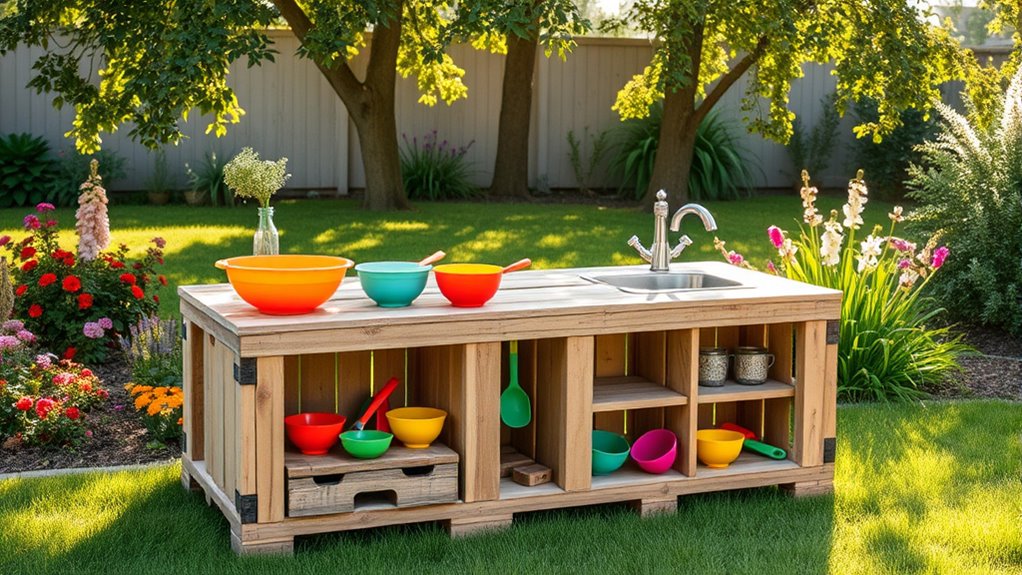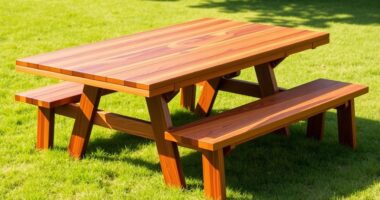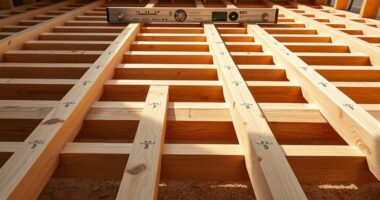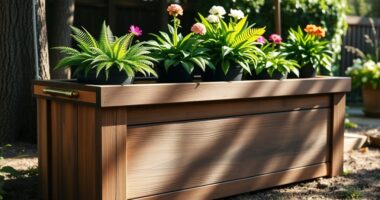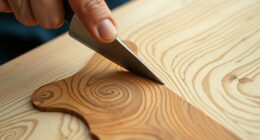To build a safe backyard mud kitchen from pallets, choose sturdy, untreated pallets free from chemicals or splinters, and inspect them carefully. Securely fasten and smooth all edges, replacing damaged parts as needed. Place the structure on a flat, well-drained area with soft ground cover, and keep it at a kid-friendly height. Regular safety checks and natural materials help guarantee a fun, hazard-free environment—keep going to discover detailed steps for a secure setup.
Key Takeaways
- Select untreated, weather-resistant pallets free from splinters, nails, and chemicals for a safe, natural play environment.
- Use stainless steel fasteners and smooth all edges to ensure structural stability and prevent injuries.
- Place the mud kitchen on a flat, well-drained surface with soft ground cover for stability and safety.
- Regularly inspect and maintain the structure, replacing damaged parts and sanding rough surfaces.
- Position the kitchen at a comfortable height and add protective barriers or soft surfaces around the area.
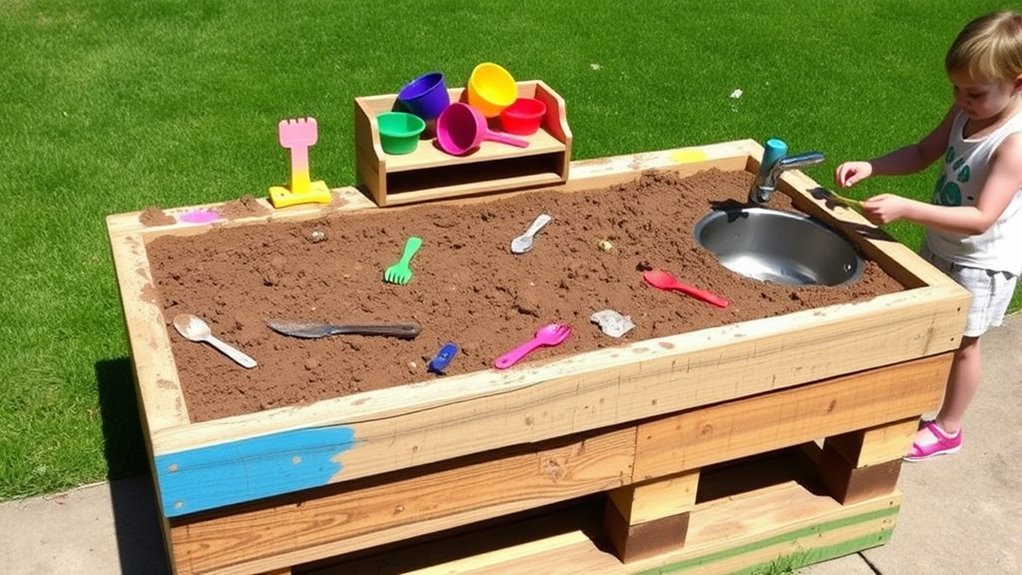
Creating a kid-safe backyard mud kitchen from pallets is a fun and affordable way to encourage imaginative play while keeping safety in mind. When building your mud kitchen, prioritizing pallet safety is essential to ensure your little ones can enjoy outdoor play without risk. Start by selecting sturdy, untreated pallets free from splinters, nails, or loose wood pieces. You want the pallets to be solid enough to withstand active play and weather conditions, so inspect each one thoroughly before using it. Avoid pallets that have been treated with chemicals or pesticides, as these substances can be harmful to children when touched or ingested. Using only safe, natural materials creates a healthier environment for outdoor play.
Choose sturdy, untreated pallets free from splinters and chemicals for a safe backyard mud kitchen.
Once you’ve chosen the right pallets, consider how you’ll assemble them to form the structure of the mud kitchen. Use galvanized or stainless steel nails and screws, since these are resistant to rust and rusted fasteners can pose safety hazards. When attaching the pallets, make sure all edges are smooth and free of sharp points that could cause cuts or scrapes. Sand down rough surfaces and sharp corners to prevent injuries during play. Securing the pallets tightly together not only provides stability but also reduces the risk of parts collapsing or shifting unexpectedly. Remember, a stable structure keeps your kids safe and allows them to focus on their creative outdoor play.
Position your mud kitchen in a flat, well-drained area of your backyard to prevent tipping or sinking into mud. A level surface ensures stability during active play and reduces accidents. To further enhance safety, consider adding a protective barrier or soft ground cover around the kitchen, such as mulch or rubber mats, to cushion falls. When designing the kitchen, keep it at a kid-friendly height, so children can comfortably reach all the surfaces and play areas. Installing a small countertop, a sink area, and storage shelves made from pallets is straightforward, but check regularly for loose parts or damage that could compromise safety. Additionally, being aware of store hours for nearby stores can help you plan your shopping trips for supplies without inconvenience.
Finally, think about the future of your outdoor play setup. Regularly inspect the mud kitchen for any signs of wear or damage, replacing or repairing parts as needed. This ongoing attention not only maintains pallet safety but also encourages children to take care of their outdoor play space. By carefully selecting materials, assembling with safety in mind, and maintaining the structure, you create a secure environment where your children can enjoy endless outdoor play. Building a pallet mud kitchen isn’t just affordable—it’s a rewarding project that sparks imagination while keeping safety at the forefront.
Frequently Asked Questions
What Safety Precautions Should I Consider During Construction?
When constructing a mud kitchen, you should prioritize safety by ensuring constant child supervision during play. Focus on weatherproofing measures, like sealing wood and using non-toxic, weather-resistant finishes, to prevent splinters and damage. Check for sharp edges or loose nails during assembly, and regularly inspect the structure for wear. By staying attentive and maintaining the kitchen properly, you create a safe, fun environment for your kids to enjoy.
How Can I Customize the Mud Kitchen for Different Ages?
To customize the mud kitchen for different ages, you should include age-appropriate accessories that suit their motor skills and interests. Consider adding adjustable height features so younger kids can comfortably reach everything, while older children can use it at a higher level. This flexibility makes the kitchen versatile, ensuring safe, engaging play for kids of various ages, and encourages creativity as they grow.
What Eco-Friendly Materials Are Best for the Project?
When choosing eco-friendly materials, you want recycled options like reclaimed wood or plastic to reduce waste. Opt for non-toxic finishes, such as natural oils or water-based paints, to guarantee safety for kids. These materials help you create a sustainable and safe environment. Always check labels to confirm they’re free from harmful chemicals, making your mud kitchen both eco-conscious and kid-friendly.
How Do I Maintain and Clean the Mud Kitchen Regularly?
Sure, maintaining a muddy marvel sounds like a chore, but it’s actually fun! With simple cleaning routines—like rinsing often and wiping surfaces—you keep it safe and inviting. Maintenance tips include checking for splinters or loose parts and replacing worn-out wood promptly. You’ll love how easy it is to keep your kid’s mud kitchen clean, ensuring endless messy adventures without turning into a full-time cleanup nightmare.
What Budget Should I Expect for Building This Project?
You’re wondering about the budget estimate for your project. Expect material costs to vary based on the supplies you choose, but generally, you should budget around $50 to $150. This covers pallets, non-toxic paint, and basic tools. If you add extra features or higher-quality materials, costs can increase. Planning ahead helps keep expenses manageable, so set a clear budget and shop for affordable, safe materials to bring your kid-safe mud kitchen to life.
Conclusion
Now that you’ve built this backyard mud kitchen, you’ve created a playground where imagination runs wild like a river. It’s more than just a project; it’s a foundation for endless adventures and messy memories. With your safe and sturdy creation, your kids can explore, create, and play freely—like chefs in their own culinary kingdom. So, let the adventures flow, and watch your backyard transform into a magical, muddy wonderland where your little ones can thrive.
